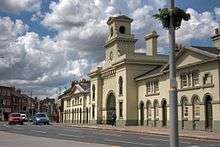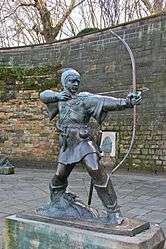Nottingham General Cemetery
Nottingham General Cemetery is a place of burial in Nottingham, England which is Grade II listed.[1]
 The cemetery gatehouse and almshouses of 1837-40 | |
| Details | |
|---|---|
| Established | 1836 |
| Location | |
| Country | England |
| Coordinates | 52°57′28″N 1°9′32″W |
| Owned by | Nottingham City Council |
| Size | 18 acres (7.3 ha) |
| No. of interments | 150,000+ |
History
The Nottingham General Cemetery Company received Royal Assent for their Act of Parliament on 19 May 1836. The initial site comprised 14 acres (5.7 ha) but in 1845 it was extended by 4 acres (1.6 ha).
In 1837-40, the cemetery gatehouse with almshouses was constructed to the designs of the architect Samuel Sutton Rawlinson at the top of Sion Hill, now Canning Circus. The wrought iron gates were made by Falconer and Company of Derby.[2] Rawlinson also provided two mortuary chapels, one for Anglicans in 1840, and the other for dissenters in ca. 1850.
The laying out of the cemetery was completed by 1838[3] with a single grave available for 7s 6d (equivalent to £34 in 2019),[4] a private grave the property of the purchaser in perpetuity from £2. 2s (equivalent to £190 in 2019)[4]and upwards, and a brick grave or vault from £10. 10s (equivalent to £952 in 2019)[4] and upwards.
In 1923 the Medical Officer of Health expressed concern about the future of the cemetery and a bill was taken to Parliament to prevent new burials except in existing family plots.
After the Second World War, the cemetery company went into liquidation, and after a period of ownership by the Crown, the freehold passed to Nottingham City Council in 1956. The mortuary chapels were both in a state of disrepair and were demolished in 1958.
War graves
The cemetery contains the war graves of 336 Commonwealth service personnel and one Belgian war grave from World War I, and of 10 from World War II. Most of the dead were from wartime military hospitals in the city. Over 100 of the graves from the first war are in a war graves plot where an adjoining screen wall lists the names.[5] The Commonwealth War Graves Commission continue to maintain the graves.
Notable interments
- William Booker (architect) 1863
- Ann Taylor (poet) 1866
- Samuel Morley (VC) 1888
- Samuel Cox (minister) 1893
- Bell Taylor surgeon 1909
- Francis Marshall Ward singer 1914
- William Brandreth Savidge architect 1939
- Henry Sulley architect 1940
References
- Historic England. "General Cemetery (Grade II) (1001487)". National Heritage List for England. Retrieved 21 July 2019.
- Harwood, Elain (2008). Pevsner Architectural Guides. Nottingham. Yale University Press. p. 130. ISBN 9780300126662.
- "Nottingham General Cemetery". Nottingham Journal. England. 13 July 1838. Retrieved 20 July 2019 – via British Newspaper Archive.
- UK Retail Price Index inflation figures are based on data from Clark, Gregory (2017). "The Annual RPI and Average Earnings for Britain, 1209 to Present (New Series)". MeasuringWorth. Retrieved 2 February 2020.
- https://www.cwgc.org/find-a-cemetery/cemetery/nottingham-general-cemetery/
